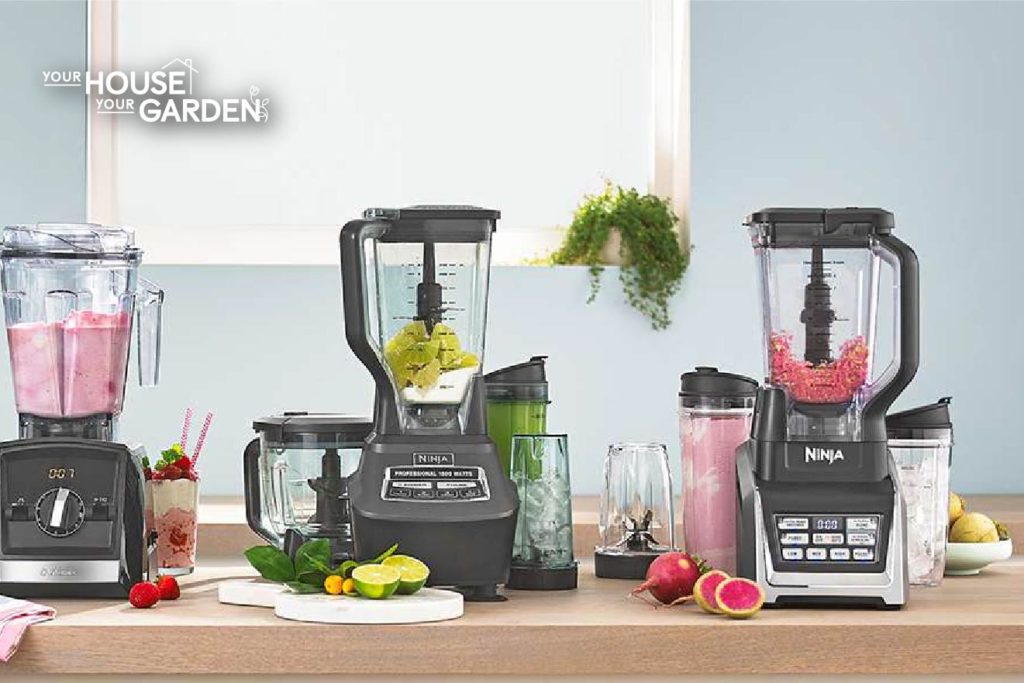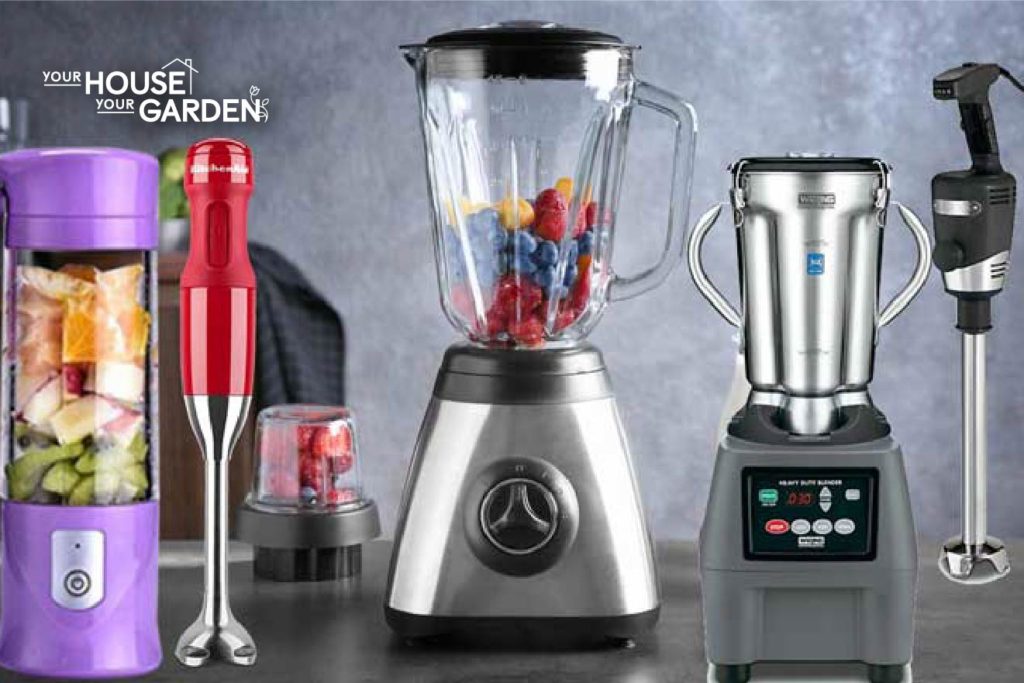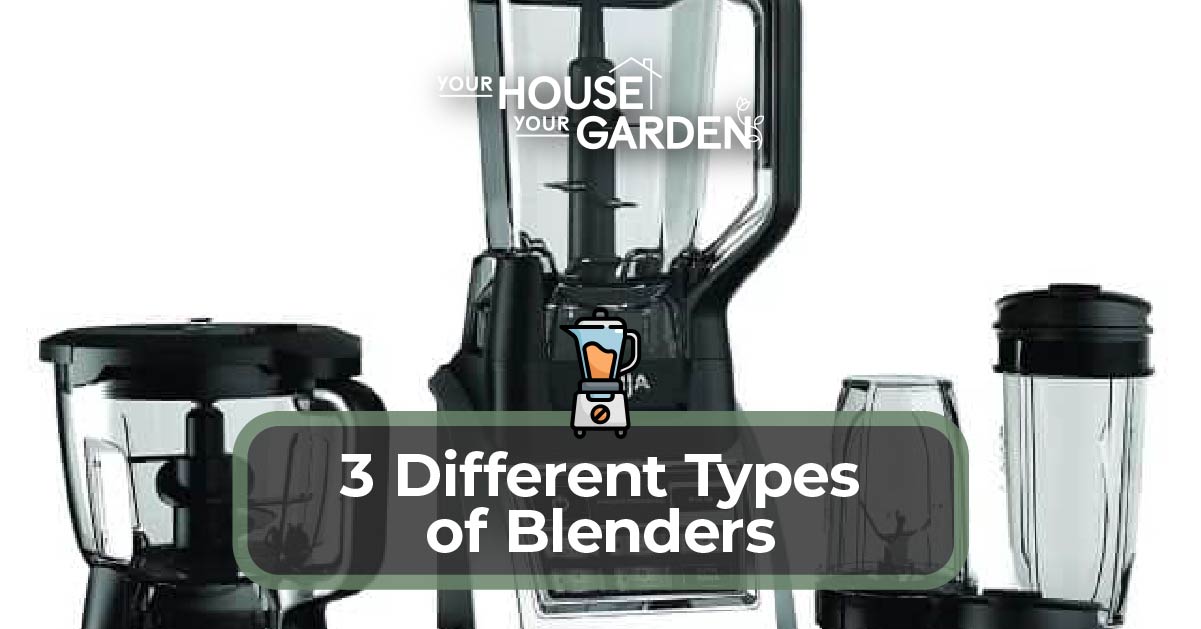There are three distinct types of blenders to choose from—countertop, immersion, and personal blender. Buying the best blender for your household and kitchen needs boils down to features, functionalities, material, brand, and price.
Blenders vary in size, noise level, style and looks, capacity, pre-determined settings, power, speed, and dishwasher-friendly parts. Some models are meant for a specific use—cake blenders are for baking, while a countertop blender can have multiple functionalities.
It is essential to know the different blender types, the pros and cons of each, and their difference from other kitchen appliances like the juicer to decide which you should buy for your kitchen.
Available Types for a Blender
Countertop blender
A countertop blender is a large, powerful blender typically used to make soups, sauces, and smoothies. It usually has a pitcher or jar that attaches to the base and blades that rotate at high speeds to chop and blend ingredients.
Countertop blenders are excellent in any kitchen because they are powerful. They can easily blend tougher ingredients such as ice or frozen fruits. They also typically come with multiple speed settings, which allows you to adjust the blending according to your needs. They come with additional attachments such as a whisk or food processor, making them more versatile.
However, countertop blenders are larger and heavier than personal blenders or immersion blenders, making them difficult to store in a tiny kitchen or small storage spaces. They can also be noisy when in use and can be more expensive than other types of blenders.
Nevertheless, there are many reasons why users prefer countertop blenders over personal or immersion blenders.
The powerful motor of a countertop blender can make quick work over tough ingredients, making it ideal if you want to make a variety of dishes like soups, sauces, or smoothies.
The multiple speed settings on most countertop blenders give you more control over the blending process to create the perfect consistency for your needs.
The additional attachments that some countertop blenders come with (such as a whisk or food processor) make them better than other types of blenders—you can use them for more than just blending, making them a more versatile kitchen appliance.
Immersion blender
An immersion blender—also known as a stick or hand blender—is a handheld kitchen appliance used for blending ingredients or puréeing food. The immersion blender is submerged in the food to be combined, making it ideal for soups, sauces, smoothies, and baby food.
There are several advantages of using an immersion blender over a personal or countertop blender. Immersion blenders are much easier to clean since there are no hard-to-reach crevices for food to get stuck in. They are also more compact and can be stored away easily.
Immersion blenders are less expensive than both personal and countertop blenders. They can be used directly in pots, pans, and other containers, making them ideal for small kitchens or those who don’t want to dirty an extra dish.
However, they are not as powerful as countertop blenders, so they may not be able to handle tough ingredients like ice or nuts. Immersion blenders can also be challenging to use for large batches of food. When it comes to cleaning and usage, the blades of an immersion blender can be sharp and dangerous—they can cut the skin if not used properly.
Overall, immersion blenders are an excellent choice for an easy-to-use, clean, compact, and affordable appliance. They are perfect for small kitchens or those who don’t want to dirty an extra dish. However, they may not be the best choice for those who need a powerful blender or who wish to blend large batches of food.
Personal blender
A personal blender is a small, handheld blender ideal for blending individual servings of smoothies or other beverages. Personal blenders are often more compact and lightweight than larger countertop blenders, making them easier to transport and store.
Personal blenders typically come with a single blending jar or cup, which can also be used to drink from or store the blended beverage. Some personal blenders also come with additional cups or pots, making them even more versatile.
When shopping for a personal blender, it is essential to consider the most important features to you. Some personal blenders have multiple speed settings, while others have only one speed. Some come with additional attachments like a chopper or mill, making them even more versatile.
The most significant advantage of a personal blender is its convenience—they are easy to use and clean and can be taken with you on the go. They are also much less expensive than countertop blenders.
However, personal blenders are not as powerful as countertop blenders. This means that they may not be able to handle tough ingredients or large batches of food.
Different Ways to Use a Blender?
There are many different ways to use a blender:
- Making smoothies, shakes, and soups
- Pureeing vegetables and fruits
- Emulsifying liquids
- Creating sauces and dressings
- Grinding spices
Each method requires different techniques and results in a unique finished product.
Smoothies are a refreshing and healthy way to start the day or enjoy as a snack. Blend your favorite fruits, vegetables, and liquids until smooth.
Making shakes: Shakes are thick and creamy beverages made with or without ice cream. Add milk, ice cream, and your favorite flavorings to the blender. Turn into the shake setting and blend until thick and creamy.
Making soups: Soup is classic comfort food that can be made quickly and easily in a blender. Add your favorite vegetables, broth, and spices to make soup. Blend until smooth.
Pureeing vegetables: Vegetables can be pureed to create various textures—from chunky to smooth. Add your vegetables from the fridge to the blender with some water or broth and blend until the desired consistency.
Fruit purees: Pureed fruit can be used to make jams, jellies, sauces, and more. Just mix your favorite fruits into the unit with some water or juice and turn on the puree setting.
Emulsifying liquids: A blender can be used to emulsify liquids like oil and vinegar to create dressings and sauces. Add them together and blend until they combine into your desired texture for dressings and sauces.
Grinding spices: Blenders can also grind whole spices into a fine powder. Place them into the unit and blend until they achieve your desired consistency.
Blenders are versatile in the kitchen. To maximize their functionalities, you must know the various ways on how to use a blender.

Sizes of Blenders
The different blender types come in various shapes and sizes.
A countertop blender has the largest capacity among all the types of blenders. It is often designed to accommodate 64 oz or larger, which is equivalent to 5 to 8 cups.
An immersion blender’s dimensions are approximately 6.5 x 6.5 x 41.3 centimeters and vary in length. Most models at home often come in a 20-centimeter blending arm, while those used for soups are as long as 30 centimeters.
Some of the more popular personal blenders come in a dimension of 40.6 L x 35.6 W x 30.5 H centimeters.
Countertop Blenders vs. Immersion Blenders
When it comes to blenders, there are two main types: countertop blender and immersion blender. So, which one is the better blender?
Countertop blenders are the more traditional type of blender. They typically come with a pitcher or jar to which you add your ingredients. They also have more robust motors than immersion blenders to handle more tough blending tasks.
However, countertop blenders can be bulky and difficult to clean. They also require more preparation time since you have to chop up your ingredients into smaller pieces before adding them to the blender.
This type of blender may not be ideal for tiny kitchens with inadequate countertop space and drawers as it requires enough room for storage.
Immersion blenders, on the other hand, are much more convenient. Put your ingredients into a pot or bowl and then blend them right in, saving time on prep work and making cleanup a breeze.
However, immersion blenders are not as powerful as countertop blenders, so they may not be able to handle demanding blending tasks.
So, which type of blender is better? It depends on your needs.
A countertop blender is your best bet if you want a powerful blender to handle demanding tasks. If you want something more convenient and easy to use, an immersion blender is the way to go.
What Foods Can I Blend in Different Blenders?
Foods that can be blended with each blender type are listed below:
- Countertop blender
Countertop blenders are great for blending a variety of foods. Some of the most popular foods to mix in a countertop blender include:
- Fruits like berries, bananas, and mangoes
- Vegetables such as carrots, celery, and tomatoes
- Nuts and seeds like almonds, cashews, and sunflower seeds
- Dairy products like milk, yogurt, cheese, and ice cream
- Other ingredients like chocolates, coffee beans, and even ice cubes
- Immersion blender
One of the great things about immersion blenders is their versatility. Not only can they be used to blend a variety of different foods, but they can also be used to puree, chop, and even emulsify.
Some of the most common foods blended using an immersion blender include soups, sauces, smoothies, and baby food. However, that is not to say that these are the only things that can be blended.
Other everyday items that can be easily blended using an immersion blender include:
- Fruit and vegetable purees
- Dips and spreads
- Pesto
- Hummus
- Salsa
- Guacamole
- Creamy soups
- Frozen drinks
- Milkshakes
- Omelets
- Quiche
- Cake batter
- Cookie dough
- Iced coffee
- Whipped cream
- Mayonnaise
- Vinaigrettes
- Mashed potatoes
- Homemade nut butter
- Personal blender
Personal blenders are great for fruits, vegetables, and protein shakes. Fruits and vegetables can be easily combined in a personal blender to create healthy smoothies. Protein shakes can also be made using a personal blender, which is ideal for those who are looking to increase their protein intake.
Some personal blenders come with specific attachments that allow them to blend other types of foods, such as nuts and seeds.

Criteria for the Best Blender Type
When looking for the best blender for your needs, there are various factors to consider. The criteria include power, capacity, speed settings, attachments, price, and brand.
Performance can be determined by how well the blender can handle different tasks, such as chopping, pureeing, and emulsifying. The best blender should be able to take all of these tasks quickly and easily.
Capacity is another essential criterion to consider. If you often entertain or have a large family, you’ll need a blender with a larger capacity like a countertop blender. However, if you’re single or have a small family, a smaller capacity blender like immersion or personal blender will suffice.
Speed settings are also crucial. If you want to be able to make quick and easy smoothies, you’ll need a blender with high-speed settings. However, if you’re looking to create more complex recipes, such as soups or sauces, a blender with lower speed settings will be enough.
Attachments are another thing to consider when choosing a blender. Some attachments, such as a food processor, can be handy. Like a juicer attachment, others may not be necessary for your personal needs and preferences.
Price and brand are common factors in choosing the best blender. A blender can cost $25 to $700, depending on the size, material, type, and brand. Those in the higher end of the spectrum are professional-grade and heavy-duty models often used in restaurants and other food service establishments.
When choosing the best blender for your needs, it’s essential to consider all of these factors. By doing so, you’ll be sure to find the perfect blender for your kitchen.
Blender and Safety
Blenders are a relatively safe kitchen appliance as long as they are used correctly.
There are some potential hazards associated with them, but these can be easily avoided with proper use and care.
The most significant hazard associated with blenders is cutting. The blades of a blender are very sharp and can easily cause cuts if they come into contact with skin. Be careful when handling the blender and make sure that the blades are not exposed.
Another potential hazard is getting hit by flying food or liquid—especially if the blender is not properly secured to the countertop or the lid is not on tight. Ensure that the blender is securely attached to the counter and that the cover is on tight before turning it on.
With all of the blades and the high speed that blenders operate at, it’s no wonder that people are concerned about safety. With a little bit of care, you can avoid the potential hazards and enjoy using your blender without worry.
Blender and Price
A blender can cost $25 to $700, depending on the size, material, type, and brand. Professional-grade and heavy-duty models often come with a $500 and up price tag and are often used in restaurants and other food service establishments.
The Lifespan of Different Blender Types
Blenders often last for 3 to 5 years on average. The more expensive units manufactured by reliable brands can last for up to 10 years.
Blender Types and Food Taste
Blended food doesn’t necessarily change the taste, but some people do notice a difference in texture.
For some, blended food can be more appealing than consuming whole fruit. Some people even find that they like blending their fruits and vegetables because it’s easier on digestion, while others need some time getting used to having a smoothie.

